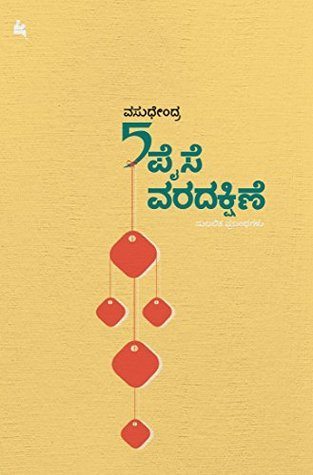Kannada author Vasudhendra (he uses only one name professionally) is not a technology n00b. The author of 13 books graduated from what today is National Institute of Technology, Surathkal, and has a postgraduate degree in engineering from Indian Institute of Science in Bengaluru. Before turning to writing full time, he was a software professional for 20 years, and held a top position at Genisys Software.
Which is why when Vasudhendra, who’s written the novel Harichitta Satya (The Infallibility of Divine Will) and collections of short stories and essays, wanted to publish his latest book, Aidu Paise Varadakshine (5 Paise Dowry), a collection of personal essays, on the Kindle digital platform, he didn’t go the usual route that Kannada authors take when they want their books to be part of the Amazon Kindle library. Since Kindle doesn’t support the Kannada font, most authors upload PDF versions of the printed books.
Vasudhendra was unhappy with the rendering of books in this format, as this essentially means pages of the book are converted into images, thereby losing essential features like word wrapping and the ability to change font size, which make reading on an e-book reader an enjoyable experience.

Users who bought and downloaded the books on to their Kindle devices or Kindle apps on their smartphones received a set of simple instructions that would help them easily access the Kannada text on their devices.
“In fact, those using the Kindle app on iPhones or iPads could skip this as the text would appear directly on their screens. Given that most Kannada readers who are tech-savvy enough to read on digital devices would find it pretty simple to follow these instructions, I thought we had found a good solution rather than using the clumsy workaround of uploading pdf files. I felt we were helping to see Kannada into the digital age,” Vasudhendra told FactorDaily in a telephonic interview.
The book went online around August 1, and was receiving good reviews including readers who were “excited to see Kannada on Kindle”, when Vasudhendra got an email from Amazon saying there was an error in the book and it was being removed from Kindle. “From what I understand, they have a lot of protocols, such as every book should have dictionary support, the font has to be directly supported by Kindle etc. Also, as I understand, they are planning to introduce Indian languages in a phased manner, starting with languages such as Gujarati, Marathi and Hindi, and they may have felt this wasn’t fitting in with their plans,” says Vasudhendra. “I have written to them asking for an explanation, but haven’t received any response yet.”
FactorDaily has also reached out to Amazon, asking for its views on the matter, but is yet to hear from them.

Meanwhile, the issue has assumed political overtones. The Kannada Sahitya Parishat, a body representing Kannada authors, has been speaking to newspapers and other media outlets about Amazon ignoring Kannada even as it gears up to launch e-books in other Indian languages. They clearly feel Amazon is meting out stepmotherly treatment to Kannada despite being headquartered in India in Bengaluru.
“Regional language newspapers and publications have huge reach. Just look at DailyHunt, which are giving digital access to Indian language content to a huge number of people. Kannada has a strong and vibrant literary tradition and has a huge readership base not just in Karnataka but elsewhere in India and abroad. A large number of them are also well-off and tech-savvy — the kind of people most likely to buy e-books and Kindle devices. In this scenario, it is pretty puzzling to me why they would ignore Kannada,” questions the author. For digital publishing platforms, often the real reason for not supporting a particular script is not enough business to implement that encoding format, but that argument, the author feels, is invalid here.
“There are no technical challenges, there are only mindset challenges,” says UB Pavanaja, a Kannada-language computing and digital content expert, also Programme Manager – Indic at The Centre for Internet & Society, who has worked extensively on creating Wikipedia entries in Kannada. “Unicode has been available on every platform for the past 15 years. There are no technological barriers to Amazon not doing this, but they have to be willing to do this. It’s a classic chicken-and-egg situation; you won’t give the technology saying there aren’t enough users but there will never be enough users and awareness till the technology is actually available,” he says.
“Indian language content is only about 0.01% of all online content. It’s not just about digital equality, it is also about a huge business opportunity,” says Arvind Pani, CEO of Reverie Language Technologies.
The whole issue also highlights many larger questions of non-English language content on digital platforms. According to Pavanaja, companies such as Amazon who “don’t want to do business with 85% of the Indian population, which is non-English speaking” are being foolish.
Arvind Pani, co-founder and CEO at Reverie Language Technologies, also shares these views about Indic language content and services on digital platforms. In an earlier conversation with FactorDaily, Pani had said that the language barrier on the internet is not a “technology problem but a user experience problem.”
“Indian language content is only about 0.01% of all online content. It’s not just about digital equality, it is also about a huge business opportunity,” says Pani. According to Reverie’s research, the next few hundred million internet users in India are going to be non-English speakers.
Pani feels that digital companies are not paying enough attention to this potentially humongous user base. Earlier this year, Reverie launched an Indic language keyboard app called Swalekh, which supports over 20 Indian languages.
While the Amazon vs Kannada authors issue is an easy enough fix if Amazon allows Unicode-compliant Kannada fonts to be enabled on the platform — Vasudhendra says if secondary features like dictionary support are a challenge, they can be incorporated in a phased manner — the larger question it raises is of the 85% Indian population that is hungry for Indian language content. And consumer-facing businesses like Amazon will come up against this problem sooner or later.
Subscribe to FactorDaily
Our daily brief keeps thousands of readers ahead of the curve. More signals, less noise.
To get more stories like this on email, click here and subscribe to our daily brief.
Disclosure: FactorDaily is owned by SourceCode Media, which counts Accel Partners, Blume Ventures and Vijay Shekhar Sharma among its investors. Accel Partners is an early investor in Flipkart. Vijay Shekhar Sharma is the founder of Paytm. None of FactorDaily’s investors have any influence on its reporting about India’s technology and startup ecosystem.








